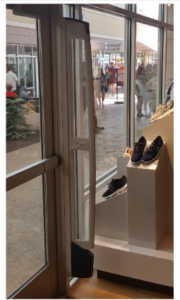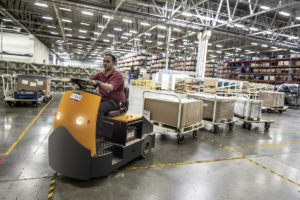Not Planning For Summer Customer Traffic In March Is Madness

Have you ever noticed how quickly big box retailers will transition from the Christmas season in their “seasonal” departments to jumping into the new Spring/Summer merchandising sets? They don’t play around they are very strategic in their planning to get a jump on their competition. They use their mini-seasonal areas to drive the Valentine’s Day and Easter business but the large areas used for patio sets, plants, gardening, etc. get changed shortly after the Christmas season is over. Smaller retail stores should be doing their own transitions at this time too. It’s madness if you haven’t started putting out the Spring/Summer merchandise for your type of store by March.
I understand there are some types of retail stores where it would seem a bit more difficult to appeal to a seasonal change. I think of luggage stores or perhaps a “mom and pop” corner grocery store where customers are used to purchasing their staple food items. But let’s think about this for a moment. Is there room for even the least seasonal retailer to adapt to seasonal sales? I would suggest there is room and it may take a bit of getting out of a comfort zone. Let’s say you sell luggage and people are going to come to your store who travel at all times of the year. Is it possible for you to carry some items that may be more colorful to appeal to a summer traveler? Think about how much easier it would be to locate a unique or brightly colored suitcase if it is on an airport carousel. While some shoppers (such as I) might prefer a traditional dark colored carry- on bag or briefcase, there are those people who fancy a more whimsical style. A change of colors and patterns might draw in more customers especially with the right touch of advertising and product placement.
Mom and Pop grocers, sure milk, eggs and bread may be your bread and butter (pun intended) but is there any reason you couldn’t put out a display of Igloo coolers, picnic grills, aluminum foil, six-packs of soft drinks or beer? How about a front of store display with these items, grilling aprons and advertising for specials on lunchmeats, steaks and hotdogs directing consumers to your cooler section? Sometimes we all get in ruts and we fail to look outside the box for new and creative ideas to keep a business fresh and improve sales.
There are the stores out there that just seem to always maintain the same set up and merchandising year in and year out. I can think of a local hardware store I sometimes go to when I don’t feel like fighting the other shoppers at the national hardware chain stores. When I do go to this particular store I usually have to search a bit to find what I need, it isn’t super neat but everything seems to be where it has been for the past fifteen years I have shopped there. It does make me wonder if the owner is trying to reach out to new customers or worries about the competition from the big box stores. A few changes now and again could probably make an impact on sales but that is a choice that owner has to make. What kind of changes would I suggest? I would put out new signs to let customers know about any sales that are running. Place gardening tools and gloves, tillers and lawnmowers at the front of the store. If the store has electronic article surveillance towers, upgrade them so that advertising panels can be interchanged and catch customer’s attention as they walk in.
Seasons change and retail stores should too, before the beginning of the next season. Take a look at a national clothing retailer the next time you walk into a store. It may be January and they will start putting out swimwear when you are still wearing a jacket. Smaller retailers can take a lesson from the large chain stores. I am not saying to become them, but there are some tips and tricks you can take away. March is here and now is the time to rebound from your winter season and spring into action by driving those summer sales.
 Hiring employees is hard enough for retail owners without the pressures of hiring seasonal staff during the holidays as many stores are now doing. Under normal circumstances, managers and owners of retail businesses are stretched thin keeping a store operating efficiently. When turnover occurs more time is taken up as those managers are forced to focus their energies on filling holes in the weekly schedule. Job ads are posted and often paper applications are handed out as interested persons come in to respond to the ad or a “Help Wanted” sign posted in a window. Then there is the security risk that is involved in the hiring of new employees whether they are seasonal or to be a regular member of a team. A new hire carries an unknown quality and there is always the off chance that with even the best interview a criminal can slip between the cracks, the proverbial wolf in sheep’s clothing.
Hiring employees is hard enough for retail owners without the pressures of hiring seasonal staff during the holidays as many stores are now doing. Under normal circumstances, managers and owners of retail businesses are stretched thin keeping a store operating efficiently. When turnover occurs more time is taken up as those managers are forced to focus their energies on filling holes in the weekly schedule. Job ads are posted and often paper applications are handed out as interested persons come in to respond to the ad or a “Help Wanted” sign posted in a window. Then there is the security risk that is involved in the hiring of new employees whether they are seasonal or to be a regular member of a team. A new hire carries an unknown quality and there is always the off chance that with even the best interview a criminal can slip between the cracks, the proverbial wolf in sheep’s clothing. As of September 2018, the national unemployment rate is down to 3.7% according to ncls.org. As a retail store owner thinks about what this means for you in terms of trying to hire to fill job openings including seasonal hiring for the holidays. With an employment rate of 96.3% that leaves a sparse workforce as a hiring pool. I have read articles by those who think that with a dwindling number of people seeking work employers are going to have to forego pre-employment background checks. They seem to believe that the need to hire outweighs any baggage the job candidates bring with them.
As of September 2018, the national unemployment rate is down to 3.7% according to ncls.org. As a retail store owner thinks about what this means for you in terms of trying to hire to fill job openings including seasonal hiring for the holidays. With an employment rate of 96.3% that leaves a sparse workforce as a hiring pool. I have read articles by those who think that with a dwindling number of people seeking work employers are going to have to forego pre-employment background checks. They seem to believe that the need to hire outweighs any baggage the job candidates bring with them.  Now that fall is upon us it is getting darker earlier. These hours of darkness can bring unique challenges for retail owners. Have you ever considered that it is your responsibility to help keep customers and employees remain safe while they are on your property? It may make sense that you are responsible for employee safety but you are also obliged to help keep customers safe as well. This includes your parking lot and the exterior areas around the building. How do you do this? What do you have to protect against? Good questions and hopefully we can provide you with answers to those questions and suggestions to make your business safer.
Now that fall is upon us it is getting darker earlier. These hours of darkness can bring unique challenges for retail owners. Have you ever considered that it is your responsibility to help keep customers and employees remain safe while they are on your property? It may make sense that you are responsible for employee safety but you are also obliged to help keep customers safe as well. This includes your parking lot and the exterior areas around the building. How do you do this? What do you have to protect against? Good questions and hopefully we can provide you with answers to those questions and suggestions to make your business safer. We are excited to announce our partnership with Johnson Controls/Sensormatic. Sensormatic is one of the oldest and largest Electronic Article Surveillance (EAS) manufactures in the world. Loss Prevention Systems has deep loss prevention and EAS experience.
We are excited to announce our partnership with Johnson Controls/Sensormatic. Sensormatic is one of the oldest and largest Electronic Article Surveillance (EAS) manufactures in the world. Loss Prevention Systems has deep loss prevention and EAS experience. Pricing is also a factor. Sensormatic line of systems will fit a wide range of budgets depending on the features you select. We also have people counting, and data reporting. This gives the Retailer important intelligence on customer traffic and flow. We have seen many of our customer’s significantly reduce expenses in both payroll and operating costs by having this data. Store hours can be adjusted and you can adjust staffing to fit the real world.
Pricing is also a factor. Sensormatic line of systems will fit a wide range of budgets depending on the features you select. We also have people counting, and data reporting. This gives the Retailer important intelligence on customer traffic and flow. We have seen many of our customer’s significantly reduce expenses in both payroll and operating costs by having this data. Store hours can be adjusted and you can adjust staffing to fit the real world. 



 National retail chain stores often rely on a management team to handle all of the daily operations of a business. These positions vary from company to company but depending on the size and sales volume of that retailer there are different managers to oversee diverse functions. There may be soft lines and hardlines department managers, a freight manager, Human Resource Manager and a store manager. Some stores might only have a sales floor manager, freight manager, and a store manager who also functions as the human resources manager. For an independent business owner, these sub-managers might be a luxury that is not affordable to them. That means it is up to the store manager to oversee all store functions and if an employee calls out that may be one more job the manager fills for a day. This takes me back to an old saying I have heard, “Work smarter, not harder”. It is not possible for a store owner or a single manager to effectively perform all of the tasks associated with running a store every single day. Finding ways to lighten the load and improve efficiency can make life much better for a retail owner.
National retail chain stores often rely on a management team to handle all of the daily operations of a business. These positions vary from company to company but depending on the size and sales volume of that retailer there are different managers to oversee diverse functions. There may be soft lines and hardlines department managers, a freight manager, Human Resource Manager and a store manager. Some stores might only have a sales floor manager, freight manager, and a store manager who also functions as the human resources manager. For an independent business owner, these sub-managers might be a luxury that is not affordable to them. That means it is up to the store manager to oversee all store functions and if an employee calls out that may be one more job the manager fills for a day. This takes me back to an old saying I have heard, “Work smarter, not harder”. It is not possible for a store owner or a single manager to effectively perform all of the tasks associated with running a store every single day. Finding ways to lighten the load and improve efficiency can make life much better for a retail owner.
 I actually like and believe in all three of these things. When it comes to drugs they have to be the legal kind. All of us have seen the destruction that illegally used drugs cause. In a business environment, illegal drug use by an employee not only has an impact on their work performance but creates serious customer and legal issues for employers. An employee that is under the influence of any substance that influences their ability to do their job correctly or safely, will cause customers to question who they are doing business with.
I actually like and believe in all three of these things. When it comes to drugs they have to be the legal kind. All of us have seen the destruction that illegally used drugs cause. In a business environment, illegal drug use by an employee not only has an impact on their work performance but creates serious customer and legal issues for employers. An employee that is under the influence of any substance that influences their ability to do their job correctly or safely, will cause customers to question who they are doing business with. Are you hiring someone who has the tendency to steal from their employer?
Are you hiring someone who has the tendency to steal from their employer?